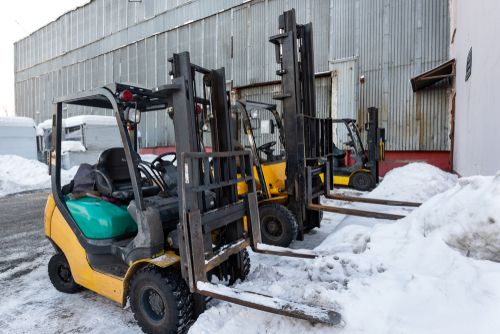Safe Loading and Unloading Practices in Icy Conditions: Preventing Accidents in Logistics
Few difficulties in the realm of logistics are as challenging as manoeuvring through icy conditions in the winter. Maintaining the integrity of the cargo and the safety of the crew become crucial in this high-stakes scenario. Adopting and strictly adhering to safe loading and unloading practices designed especially for wintry circumstances is the key to success.
In this blog, the team at Advanced CT will explore some procedures for protecting your logistics operations so they run smoothly even in the most difficult winter terrain.
Weather Observation

It’s critical to be informed about the local weather, especially in the winter. Regularly check for updates on precipitation, ice buildup, and subfreezing temperatures using reputable weather forecasting sources. Real-time data gives you the ability to manage your logistics operations appropriately, assuring the security of your workers and the cargo.
Suitable Footwear
Shoes are a key component in reducing slips and falls in icy situations. Ensure that everyone working on loading and unloading tasks is wearing proper, weather-resistant footwear. These shoes ought to feature traction-enhancing soles that are resistant to slipping on icy terrain. Winter boots of high quality can greatly lower accident risk.
Clear Ice And Snow
It is essential to remove snow and ice from the truck’s loading dock and the surrounding area before beginning any loading or unloading operations. Remove accumulated snow using snow shovels or snow blowers, and think about using deicing products to stop ice accumulation. This preliminary procedure considerably lowers the possibility of staff members sliding and suffering injuries.
Application of Sand or Salt
Consider applying salt or sand to walkways and other ice surfaces to improve safety around loading and unloading areas. Sand offers more traction, while salt helps melt ice. Apply these substances often to avoid the development of slick ice patches and lower the risk of incidents.
Employ Anti-Slip Mats
An efficient way to improve traction in icy situations is to use anti-slip mats. Place these mats in strategic locations near entrances to buildings or trucks as well as loading docks. They lessen the chance of accidents by giving workers a steady, non-slip surface to tread on. As soon as these mats begin to show signs of wear, make sure you replace them.
Suitable Lighting
When working in the morning or evening when natural light is scarce, adequate illumination is crucial. It is less likely that accidents will occur when loading and unloading areas are well-lit so that workers can see any ice spots and obstructions easily. Having adequate illumination also improves overall security and productivity during logistical tasks in the winter.
Vehicle Maintenance
For safe winter operations, it’s essential to keep your vehicles and equipment in good condition. Make sure your cars are in top operational condition by doing routine maintenance and inspections. Tires should receive extra attention; make sure they have enough tread depth and are properly inflated. On snowy terrain, well-maintained automobiles are less prone to slide or lose control.
Slow & Deliberate Motions
Stress the necessity of using slow, deliberate motions when moving merchandise under ice weather. Encourage workers to proceed cautiously whether utilizing forklifts, pallet jacks, or physically moving products. Accidents might occur as a result of sudden or rapid movements losing traction. More deliberate, slower motion contributes to stability and control.
Training

For staff operating in cold circumstances, thorough training is crucial. Give your personnel instructions on safe winter procedures, including how to spot hypothermia or frostbite symptoms. Make sure kids understand what to do in the event of emergencies or mishaps. Personnel who have received proper training are better prepared to manage bad weather.
Plan for Delays
Your logistics operations may experience delays due to winter weather. Adjust your plans and allot more time for loading and unloading tasks to account for any potential setbacks. Effective communication with customers, partners, and suppliers is vital to manage expectations and reduce the effect of delays caused by ice conditions.
Advanced CT – Leaders in Occupational Health & Safety
Safe loading and unloading practices are the key to success in the logistics industry, where precision and reliability are crucial. Embrace them, give them top priority, and allow them to lead you through winter weather to ensure that your cargo arrives successfully and that your crew makes it home without incident. Safe loading and unloading procedures are more than just a catchphrase; they hold the key to a safer, more prosperous future for your logistics projects.
Please contact us if you are looking to enhance your logistics operations for winter weather. At Advanced CT, we are aware of the crucial importance safe loading and unloading practices have in workplace safety, particularly given the difficult winter weather in Ottawa. Our goal is to provide your personnel with the knowledge and abilities needed to safely traverse ice terrains. Don’t put off taking action until the next winter. Partnering with Advanced CT can help you raise your safety standards and safeguard your staff. Our professionals are here to help you whether you require extensive safety training, compliance solutions, or tailored programs.

